Literature
At the recent conference for the Association for the Study of Literature and the Environment (ASLE), I dared my rental car company by lingering in Lawrence, Kansas for an extra couple hours, squeezing out some additional time so that I could go to a panel I was very excited about, but thought I would have to miss: it was organized around Jeffrey Jerome Cohen's forthcoming collection Prismatic Ecology: Ecotheory beyond Green.

I had heard of this book from Tim Morton (who has a chapter in it), and was intrigued to say the least. Then I met Jeffrey at ASLE (he attended the panel I organized, on "Weather Machines"), and we hung out a good deal throughout the rest of the conference; we really clicked, one of those rare encounters that is perfectly timed for innumerable and incalculable reasons. Needless to say, the panel on "Prismatic Ecologies" was excellent and stimulating?and it continues to brew in my mind. I'm eager to read the entire book, and based on what I heard in this panel, and what I know of many of the other contributors (such as Stacy Alaimo, whose plenary talk at ASLE was utterly compelling), I can imagine assigning it in my Environmental Theory course at Loyola in the future.
Just in time to avoid late fees from Enterprise, I made it back to the airport: Kansas City International, a classic (and practically instantaneously obsolete) early-1970s drive-to-gate design. Here's a breathtaking view of one of the terminals from the perspective of the shuttle bus window, en route from the rental car hub:
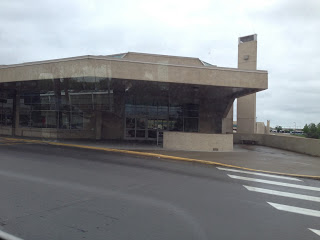
This airport is curious for the ways that the rental car hub both anticipates and rather undermines the actual airport experience. When you drop off your car, you have to wander through a cavernous terminal wherein the different rental companies are staged almost like airline check-in counters, then trudge down an escalator bank, only then to wait in a gloomy, smoggy bus garage...finally to be ferried over to the low profile C-shaped terminal buildings. By the time you get to the airport, it feels weirdly anti-climactic.
Once through security, I ordered lunch at a baseball-themed pub that served large plates of food accompanied by plastic forks and knives. As I worked on (the phrase is appropriate here) a bratwurst the size of my arm, I thought back over the conference with feelings of intellectual excitement and curiosity. (Later, reading Jeffrey's reflection on ASLE, as well as Steve Mentz's, I was heartened to see that I was not alone.)
Sitting in the airport restaurant looking out over the tarmac, I sipped a Stella Artois and scrolled through the #ASLE13 twitter feed. At some point someone retweeted a story about "hot pink slugs" that existed on some high mountain somewhere far away. This sent me back to the Prismatic Ecologies panel, and, inspired by the gauntlet thrown down by the panelists' various 'shades' beyond green, I decided to take a walk in the woods?but a very simple and ordinary walk?to see how many different colors I could find, and what they might tell me. (I also had the thought to map prismatic ecologies at the airport, but that will be a different project for another time.)
This desire to go out in the woods was then interrupted (and bolstered, too) by several flights and attendant airport layovers, followed by a 1300-mile drive across the country (long story).
But now I have done it. I went for a completely routine walk behind my summer home in northern Michigan, keeping an eye out for prismatic ecologies. As I quote from the speakers on the panel below, I should say here that these were notes taken on the fly; my apologies if I've bungled anything in hastily jotting it down. And I should admit from the outset that I've taken 'prismatic ecologies' in an almost ridiculously literal way, walking in the woods and then nature writing about it. It's just an experiment.
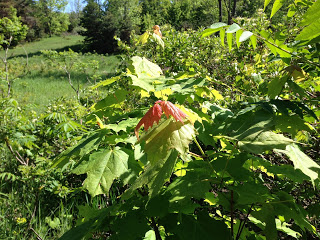
As I walked along a familiar trail back toward the forest, the first thing I noticed was how the newly emerging sapling sugar maple leaves were a brilliant pink against the more mature kelly green growth. I was just twenty yards from the house, and already I was confronted with the fact that, as Jeffrey Jerome Cohen put it, "you can't totalize green into a single system"?the tiny pink leaves in June were reminders of the late spring, and the called attention to other processes and things that resisted static coloration. I found myself looking around and zooming in and out, from the weird speckled gray glacial stones under my feet to the even weirder glowing maroon buds at the tips of the white spruce limbs. Indeed, I found that, in Jeffrey's words, "rainbows are perspectival"?the spectrum makes you take on different perspectives and adjust phenomenological registers accordingly.
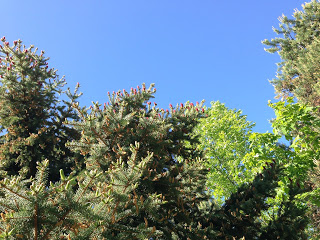
Considering the maroon buds on these spruce trees, I recalled how Lowel Duckert had offered the counterintuitive insight that "the color maroon is never alone." Even as I was isolating the buds and taking note of their color, which I'd never before noticed, I was given over to the realization, as Lowell put it, that I was not "marooned from things, but always co-implicated with them." I found myself wondering if the white spruce was a native species (turns out it is), and recalling my own thwarted efforts as a kid to climb up one to retrieve an errant frisbee (their branches become a thick matrix, and the needles very prickly; I have muscle memory of my thoroughly scratched teenage body).
Further along the trail, I passed through a sumac stand, an aspen grove, and then entered the darker climax stage forest. Among the maples and beeches, I paused to look at a decaying stump of a bigtooth aspen.
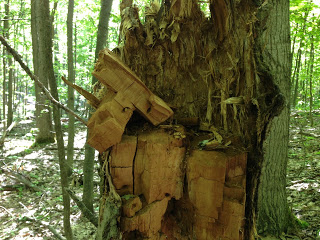
The brown chunks seemed simultaneously to be stacked intricately and falling randomly on the ground. It was true, as Steve Mentz had pointed out, that "brown is a connective color, but it can stain, too." The decomposing aspen stump was indicative of the shifting succession of my region, how the shoreline along Lake Michigan gradually changes from dune grass to junipers to pines to oaks...on and on, working through species and working them back into the soil, one day probably to be engulfed by glaciers again. The stump was an exception to the other trees, and evidence of a logic at work. I was reminded of Steve's open question about what happens when "blue turns to brown," which I took to stand for any number of slow or sudden transitions when ecosystems shift and events rupture what we thought things were supposed to look like.
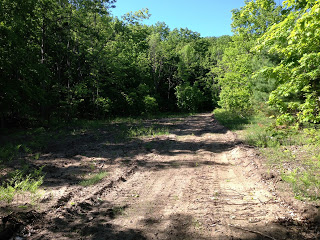
Next I entered a wide valley, where bracken ferns used to grow up as high as my waist and so dense that lying down under them was like being in a miniature forest. Now this valley is flattened and covered with deep tread marks; it is the site of the logging extravaganza that I wrote about last summer.
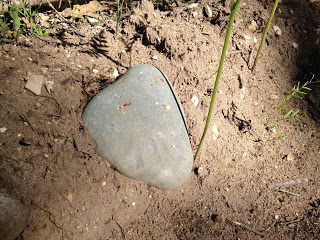
As I walked along this small wasteland, bracken fern fiddleheads just starting to reclaim the space, I spotted a smooth blue stone, and I knelt down to look more closely at the rust colored scratches on the stone: scrapes from the giant log skidder as it rolled over the valley, dragging giant white ash, sugar maple, and red oak trunks. And this blue stone sent me back to Eileen Joy's provocative segment of the panel, how she talked about a "blues ecology"?comportments such as depression, sadness, and melancholy, and how these things figure into ecological awareness. Eileen posed the question, "Do these only take place inside one? Or are they also in the world, atmospheric?" My complicated feelings about and perceptions of the aftermath of the logging operation in the woods spoke to this problem, and the blue stone at my feet became a scarred objective correlative.
Vin Nardizzi was not able to make the conference, but I was lucky enough (thanks to my colleague Hillary Eklund) to hear Vin speak at Loyola earlier this year from his chapter in Prismatic Ecology, about when ecosystems tarry with monstrosity and manufactured hybridity, and green becomes greener. Sometimes I'm overwhelmed by this sensation even when nothing seems wrong, but the forest looms around me and reminds me that I am both in it and outside it, a conscious mapper of species, property lines, and trails, and another mere mammal passing through.
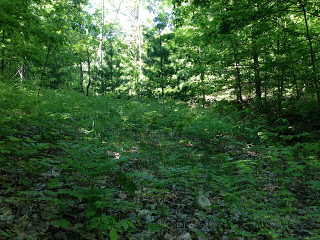
- What I Did This Summer: Connections & Reconnections
This summer has been a series of connections and reconnections for me. I've been up in Michigan, where I had planned to work on my book on the region, which I'm tentatively calling Notes from the Sleeping Bear. But instead of writing much on...
- Where I?m Coming From
Below is a short narrative I presented to the Environment Program at Loyola this past April. We begin each of our monthly meetings with a brief autobiography from one of the faculty members affiliated with the program; I've found these to be very...
- Recent Things
It has been a very busy spring, with perhaps one too many trips to the airport, even for me. My son, not yet three, can now effortlessly identify the corporate logo of Southwest (those cheery wings with a heart in the middle), delineate the various stages...
- Logging Camp
I am strongly drawn to Camp, and almost as strongly offended by it. That is why I want to talk about it, and why I can. ...
- Up In Michigan
I'm up in Michigan again this summer, where I go to write and plan my courses for the coming school year. I grew up here, traipsing around the Sleeping Bear Dunes National Lakeshore. It's a beautiful place, with sand dunes and white pines, foxes...
Literature
Reflecting on & Experimenting with "Prismatic Ecologies"
At the recent conference for the Association for the Study of Literature and the Environment (ASLE), I dared my rental car company by lingering in Lawrence, Kansas for an extra couple hours, squeezing out some additional time so that I could go to a panel I was very excited about, but thought I would have to miss: it was organized around Jeffrey Jerome Cohen's forthcoming collection Prismatic Ecology: Ecotheory beyond Green.

I had heard of this book from Tim Morton (who has a chapter in it), and was intrigued to say the least. Then I met Jeffrey at ASLE (he attended the panel I organized, on "Weather Machines"), and we hung out a good deal throughout the rest of the conference; we really clicked, one of those rare encounters that is perfectly timed for innumerable and incalculable reasons. Needless to say, the panel on "Prismatic Ecologies" was excellent and stimulating?and it continues to brew in my mind. I'm eager to read the entire book, and based on what I heard in this panel, and what I know of many of the other contributors (such as Stacy Alaimo, whose plenary talk at ASLE was utterly compelling), I can imagine assigning it in my Environmental Theory course at Loyola in the future.
Just in time to avoid late fees from Enterprise, I made it back to the airport: Kansas City International, a classic (and practically instantaneously obsolete) early-1970s drive-to-gate design. Here's a breathtaking view of one of the terminals from the perspective of the shuttle bus window, en route from the rental car hub:
Once through security, I ordered lunch at a baseball-themed pub that served large plates of food accompanied by plastic forks and knives. As I worked on (the phrase is appropriate here) a bratwurst the size of my arm, I thought back over the conference with feelings of intellectual excitement and curiosity. (Later, reading Jeffrey's reflection on ASLE, as well as Steve Mentz's, I was heartened to see that I was not alone.)
Sitting in the airport restaurant looking out over the tarmac, I sipped a Stella Artois and scrolled through the #ASLE13 twitter feed. At some point someone retweeted a story about "hot pink slugs" that existed on some high mountain somewhere far away. This sent me back to the Prismatic Ecologies panel, and, inspired by the gauntlet thrown down by the panelists' various 'shades' beyond green, I decided to take a walk in the woods?but a very simple and ordinary walk?to see how many different colors I could find, and what they might tell me. (I also had the thought to map prismatic ecologies at the airport, but that will be a different project for another time.)
This desire to go out in the woods was then interrupted (and bolstered, too) by several flights and attendant airport layovers, followed by a 1300-mile drive across the country (long story).
But now I have done it. I went for a completely routine walk behind my summer home in northern Michigan, keeping an eye out for prismatic ecologies. As I quote from the speakers on the panel below, I should say here that these were notes taken on the fly; my apologies if I've bungled anything in hastily jotting it down. And I should admit from the outset that I've taken 'prismatic ecologies' in an almost ridiculously literal way, walking in the woods and then nature writing about it. It's just an experiment.
As I walked along a familiar trail back toward the forest, the first thing I noticed was how the newly emerging sapling sugar maple leaves were a brilliant pink against the more mature kelly green growth. I was just twenty yards from the house, and already I was confronted with the fact that, as Jeffrey Jerome Cohen put it, "you can't totalize green into a single system"?the tiny pink leaves in June were reminders of the late spring, and the called attention to other processes and things that resisted static coloration. I found myself looking around and zooming in and out, from the weird speckled gray glacial stones under my feet to the even weirder glowing maroon buds at the tips of the white spruce limbs. Indeed, I found that, in Jeffrey's words, "rainbows are perspectival"?the spectrum makes you take on different perspectives and adjust phenomenological registers accordingly.
Considering the maroon buds on these spruce trees, I recalled how Lowel Duckert had offered the counterintuitive insight that "the color maroon is never alone." Even as I was isolating the buds and taking note of their color, which I'd never before noticed, I was given over to the realization, as Lowell put it, that I was not "marooned from things, but always co-implicated with them." I found myself wondering if the white spruce was a native species (turns out it is), and recalling my own thwarted efforts as a kid to climb up one to retrieve an errant frisbee (their branches become a thick matrix, and the needles very prickly; I have muscle memory of my thoroughly scratched teenage body).
Further along the trail, I passed through a sumac stand, an aspen grove, and then entered the darker climax stage forest. Among the maples and beeches, I paused to look at a decaying stump of a bigtooth aspen.
The brown chunks seemed simultaneously to be stacked intricately and falling randomly on the ground. It was true, as Steve Mentz had pointed out, that "brown is a connective color, but it can stain, too." The decomposing aspen stump was indicative of the shifting succession of my region, how the shoreline along Lake Michigan gradually changes from dune grass to junipers to pines to oaks...on and on, working through species and working them back into the soil, one day probably to be engulfed by glaciers again. The stump was an exception to the other trees, and evidence of a logic at work. I was reminded of Steve's open question about what happens when "blue turns to brown," which I took to stand for any number of slow or sudden transitions when ecosystems shift and events rupture what we thought things were supposed to look like.
Next I entered a wide valley, where bracken ferns used to grow up as high as my waist and so dense that lying down under them was like being in a miniature forest. Now this valley is flattened and covered with deep tread marks; it is the site of the logging extravaganza that I wrote about last summer.

As I walked along this small wasteland, bracken fern fiddleheads just starting to reclaim the space, I spotted a smooth blue stone, and I knelt down to look more closely at the rust colored scratches on the stone: scrapes from the giant log skidder as it rolled over the valley, dragging giant white ash, sugar maple, and red oak trunks. And this blue stone sent me back to Eileen Joy's provocative segment of the panel, how she talked about a "blues ecology"?comportments such as depression, sadness, and melancholy, and how these things figure into ecological awareness. Eileen posed the question, "Do these only take place inside one? Or are they also in the world, atmospheric?" My complicated feelings about and perceptions of the aftermath of the logging operation in the woods spoke to this problem, and the blue stone at my feet became a scarred objective correlative.
Vin Nardizzi was not able to make the conference, but I was lucky enough (thanks to my colleague Hillary Eklund) to hear Vin speak at Loyola earlier this year from his chapter in Prismatic Ecology, about when ecosystems tarry with monstrosity and manufactured hybridity, and green becomes greener. Sometimes I'm overwhelmed by this sensation even when nothing seems wrong, but the forest looms around me and reminds me that I am both in it and outside it, a conscious mapper of species, property lines, and trails, and another mere mammal passing through.
- What I Did This Summer: Connections & Reconnections
This summer has been a series of connections and reconnections for me. I've been up in Michigan, where I had planned to work on my book on the region, which I'm tentatively calling Notes from the Sleeping Bear. But instead of writing much on...
- Where I?m Coming From
Below is a short narrative I presented to the Environment Program at Loyola this past April. We begin each of our monthly meetings with a brief autobiography from one of the faculty members affiliated with the program; I've found these to be very...
- Recent Things
It has been a very busy spring, with perhaps one too many trips to the airport, even for me. My son, not yet three, can now effortlessly identify the corporate logo of Southwest (those cheery wings with a heart in the middle), delineate the various stages...
- Logging Camp
I am strongly drawn to Camp, and almost as strongly offended by it. That is why I want to talk about it, and why I can. ...
- Up In Michigan
I'm up in Michigan again this summer, where I go to write and plan my courses for the coming school year. I grew up here, traipsing around the Sleeping Bear Dunes National Lakeshore. It's a beautiful place, with sand dunes and white pines, foxes...
